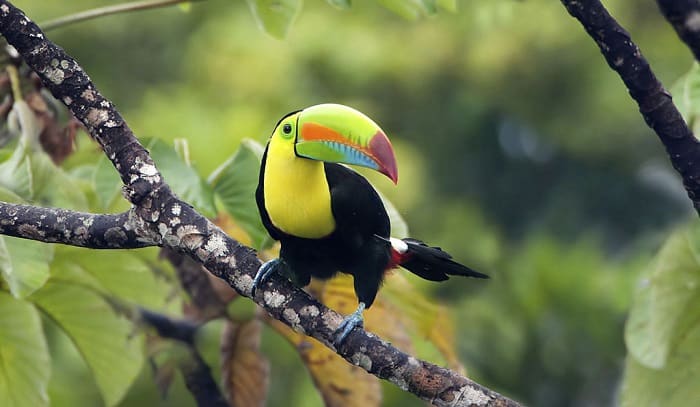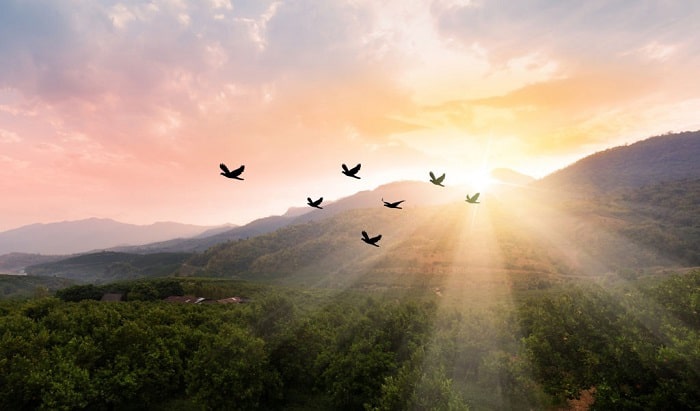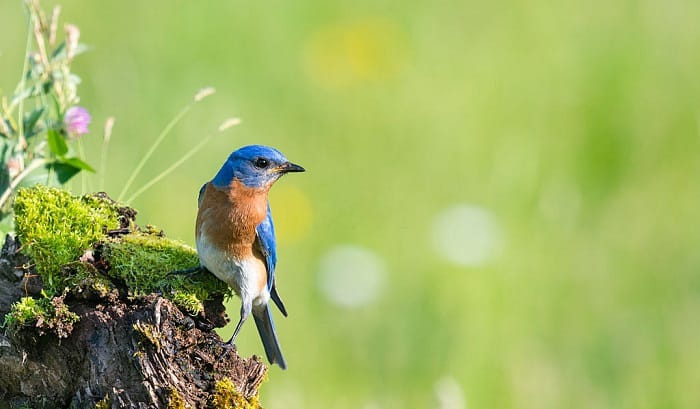How long do birds live? Does this question ever come up in your trip to the wild with friends? Or does it ever suddenly pop up in your head and poke your curiosity? Well, here’s a quick answer for you, depending on its species, a bird has a lifespan of 4 years to 100 years. Also, a common fact is that bigger birds tend to live longer.
For detailed information about the average lifespan of birds, let’s read on.
The Lifespan of a Bird
Live long and prosper. For small songbirds, that might be seven years!
A songbird in the wild has about a 25% chance of making it to its first birthday. It has less than a 50% chance of surviving more than two years. However, if a young bird can survive accidents, disease, predation, migration, and winter starvation, it may live a surprisingly long time.
As a general rule, larger birds tend to live longer. It also helps to be at the top of the food chain.
A Laysan Albatross has survived 42 years and 5 months in the wild. Parrots in captivity have been known to live over 80 years! Seabirds in the wild seem to live 30-50 years, eagles 20-25 years, hawks 8-20 years. Most songbirds might live 7-10 years, hummingbirds even less than that, and warblers may live only 3-6 years.
Here are some of the records for longevity. These are certainly not average life expectancy — these are the all time records! These figures are based on the recapture of banded birds. Bear in mind that results are a bit skewed – it is far more common for larger birds and game birds to be found and have their tags returned than it is for songbirds. The life of the bird at the time of death is shown in years and months:
| Common Loon | 12-11 |
| Laysan Albatross | 42-05 |
| Brown Pelican | 27-10 |
| Anhinga | 11-11 |
| Great Blue Heron | 23-03 |
| Green Heron | 07-11 |
| Mute Swan | 26-09 |
| Canada Goose | 28-05 |
| Mallard | 26-04 |
| Osprey | 26-02 |
| Red-tailed Hawk | 25-09 |
| American Kestrel | 13-07 |
| Northern Bobwhite | 06-05 |
| Whooping Crane | 18-10 |
| Killdeer | 10-11 |
| Herring Gull | 28-00 |
| Common Tern | 25-00 |
| Elf Owl | 04-11 |
| Great Horned Owl | 27-07 |
| Ruby-throated Hummingbird | 09-01 |
| Downy Woodpecker | 11-11 |
| Hairy Woodpecker | 15-10 |
| Red-eyed Vireo | 10-00 |
| Blue Jay | 17-06 |
| American Crow | 14-07 |
| Purple Martin | 13-09 |
| Carolina Chickadee | 10-11 |
| House Wren | 09-00 |
| Eastern Bluebird | 10-05 |
| Western Bluebird | 05-01 |
| American Robin | 13-11 |
| Northern Mockingbird | 14-10 |
| Yellow Warbler | 09-11 |
| Song Sparrow | 11-04 |
| Northern Cardinal | 15-09 |
| Western Meadowlark | 06-06 |
| Red-winged Blackbird | 15-09 |
| House Sparrow | 13-04 |
Factors That Affect Birds’ Life Span
- Size: As mentioned above, larger species, namely albatross, parrots, or raptors, live longer than smaller ones like songbirds, garden birds.
- Diseases: Common diseases among birds in a region might increase the mortality rate of the flocks.
- Injuries: Under the danger of environmental pollution or predators, they live shorter as breeding successes are low, and they are easily hurt.
- Food and habitat: Birds tend to live longer in regions where food is abundant, and living conditions are good.
- Conservation measures: It is not surprising that birds live longer in captivity with sufficient care, preserved habitat, and breeding conditions.
- Individual experience: How well a bird survives in nature is another factor that determines bird lifespan.
1. Interesting facts about bird’ ages
Birds do not age. Well, it is understandable that many of us assume birds someday turn old and saggy like many other animals. But, that is not the case. Up until a certain period of growth, they stop becoming old, thus showing signs of aging. So, we can barely tell if they are getting old or how long a bird has lived.
Longest lived birds are up to 100 years old. The longest living bird we have known of is Cocky Bennett. The 120-year old bird is a famous Sulphur-Crested Cockatoo living in Canterbury, Australia.
Another celebrity in the bird kingdom is Charlie, with a lifespan of 114 years. It is a yellow and blue Macaw living in England rumored to be once Winston Churchill’s pet.
Other birds that are famous for their impressive lifespan are Chile (around 60 years old) – Chilean Flamingo in Australia, Wisdom (about 69 years old) – a Laysan Albatross in the U.S, Thaao (80 years old) – an Andean Condor living in the U.S, Greater (around 80 years old) – a beautiful Flamingo in Australia.
And the list goes on; you can check out the list here to find out interesting things about these birds.
Here’re some bird species that have long lifespans.
- Laysan albatross usually lives for around 12 to 40 years; few can live more than 65 years, making it one of the oldest living bird species.
- Next in line is Arctic terns, with a lifespan of 15 to 30 years. Their main food is small marine invertebrates and fish.
- Brown Pelicans live around 25 – 40 years. They feed on fishes like mullets, herrings, and anchovies.
- The Great Horned Owl is another long-living bird with a lifespan of 13 to 15 years. Some of them can live up to 27 years.
- The beautiful Mute Swans also have an average lifespan of 15 – 20 years, with the longest-living ones reaching 26 years old.
- Red-Tailed Hawks can live as long as 20 years, with one of the oldest members living up to 25 years. They eat various things, from reptiles, smaller birds, insects, etc.
2. Signs to know birds with a long or short lifespan
Besides the bird’s body size that must have been the easiest clue for us to guess a bird’s life span, there are several factors that might make our speculation more exact.
- The number of chicks: For birds that have many small chicks, they tend to live shorter. We can say breeding, giving birth, and caring for many offsprings can affect birds’ health.
- Shelter: Birds that live on high shelter like a tree are reported to survive better. For species that live near the ground, we can conclude that they could have a shorter life span.
- Adulthood: As the birds do not age, their time to reach adulthood, which determines their growth, can tell us about their life span. If a bird reaches adulthood quickly, it has a shorter life.
- Wildlife: Birds in capacity with sufficient protection and care might live longer than them in the wild. But birds living on the island tend to live longer than their mainland counterparts.
How Do We Know About Birds’ Ages?
There are different methods to get the data on birds’ life span. If you are curious, here’s how the data collections go for licensed workers with this task.
They will attach a small band/ring/mini transmitter with a serial number to monitor it on the bird. They start by using a mist net to catch the bird. Of course, this step should be done with utmost care and efficiency to avoid causing stress for the bird.
Then, they can easily insert the ring onto the neck or leg of the caught bird. Afterward, the creature will be released, allowing the device to follow it everywhere and collect data about many things, not just its age.
How Do Birds Survive Weather Hazards?
Birds always seek shelter before they sleep to avoid predators. To locate a suitable shelter, they must rely on different factors, just like finding food. For instance, cavity nesters hide in tree hollows, caves, or birdhouses at night. Meanwhile, thrushes, sparrows, and many songbirds go for thick bushes to avoid predators.
Regarding the harsh weather conditions like rain or cold, they will find trees, grass, or thick bushes to keep themselves safe. Hazards like hurricanes force birds to seek safer places, but many fail to do so. Thus, in huge storms, many birds cannot survive.
Birds in Captivity and in the Wild
As mentioned above, birds in captivity tend to live longer than birds living in the wild.
The reasons for this trend are straightforward, a bird’s counterpart in the wild can suffer from a lack of food. Meanwhile, birds living in captivity do not have to spend much of their energy and time seeking food.
Furthermore, birds living in natural habitats face predators, harsh environmental conditions, and more hazards. They are more subjected to severe hurt, diseases, and fatal attacks while having the necessary medical care in such cases. Therefore, it is harder to survive in the wild than in an environment with proper care.
Conclusion
Now, you already know the answer to your question, “How long do birds live?” Hopefully, you have fun reading interesting information related to these species. They spend their lives either in the wilderness or in captivity; many factors affect their life span.
So, if you find this article helpful, do not hesitate to share it with your friends, especially those who are avid bird-watchers. Thank you!



